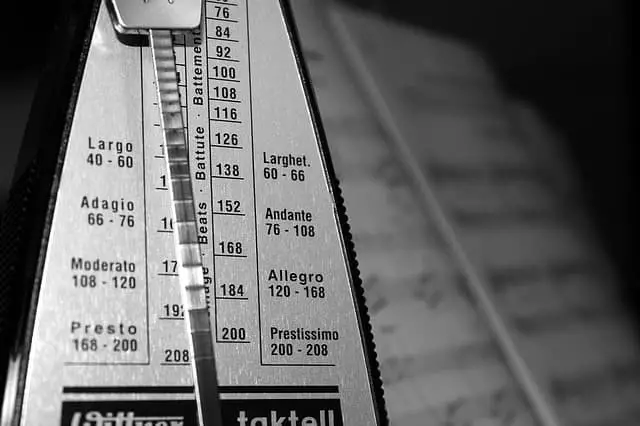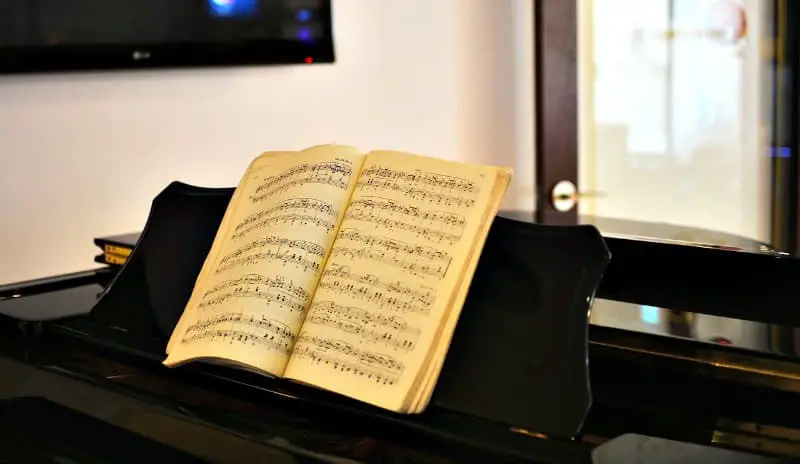- Home
- Piano Practice
- How to Use a Metronome
How to Use a Metronome
This article may contain compensated links. Please read the disclosure for more info.
Learn how to use a metronome to practice piano with great results!
A metronome is a handy tool, basically necessary, for all musicians. Here you'll learn the use of a metronome and how to practice more effectively with it.
How to Use a Metronome
1. Learning Rhythms
More than helping you keep a steady beat, learning how to use a metronome can help improve your understanding of rhythms.
When you first begin your piano lessons, it can be of help when learning about different note values:
- Pick a piece you want to learn and look at the notes' values and rests.
- Set the metronome at a slow speed, 60-80 is good. The beats can represent quarter notes, so each quarter note gets one beat.
- Practice the rhythms in the piece by pointing to each note and rest. Count along as you point, or clap the rhythm and count.
 Learn the many uses of a Metronome.
Learn the many uses of a Metronome.Counting Rhythm
As you begin counting rhythm, it is a good idea to use “Unit Counting.” This means that you count each note value precisely for its worth and not the number of beats it represents in the measure.
For example, four quarter notes, or crotchets, would be counted;
1 – 1 – 1 – 1 (instead of 1-2-3-4)
and two half notes, or semibreve:
1 – 2 1 - 2 (instead of 1-2 3-4)
Unit counting is excellent for beginners since you focus only on the length of each note instead of regular counting, where you count the beats per measure.
So the metronome reinforces learning of note values and helps you sight-read music by keeping your attention ahead in the music.
However, unit-counting only works when playing hands separately or until you start using different rhythms in each hand.
At that time, you need to use "regular" counting, beats per measure, where you follow the time signature and count as many beats as it says per measure.
How to use a metronome and play on the beat?
At first, it can be hard to play along with the beat. It seems to always play at a different speed than oneself. Try these simple tips:
- Check the time signature of the piece.
- Count in yourself for a while before you start. If the time signature is 4/4, count 1-2-3-4 a few times with the metronome to really "feel" the beat.
- As you play, if you get lost with the beat, just stop and join in the next beat.
- You can also make minor adjustments to get back on the beat as you play.
Gradually this will become easier and easier. Remember, it's just a tool! If the sound drives you crazy- just turn it off and try again later.
How Do You Practice Using a Metronome?
How to Use a Metronome: Speed Control
How to use a metronome to check that the piece's speed is accurate:
At the top of the score, usually left corner of the sheet music, you might see "Allegretto mm.120," for example.
Allegretto is a moderately fast tempo, and the metronome count helps you understand how fast this may be.
How to Use a Metronome as a Tempo Stabilizer
The metronome can be used as a tempo stabilizer. This is great when working, for example, with scales.
You may think that you play them nice and even, but make sure to test your playing with the metronome, and you will find the places where you slow down or speed up.
How to Use a Metronome to Speed Up a Piece
A metronome is an excellent tool for pieces that you have learned the notes at a slow tempo and now need to speed up.
- Start with smaller parts of the piece and put the metronome at a comfortable and slow tempo, where you can play without any mistakes.
- As soon as you play through the part once without mistakes, increase the speed with one click.
- Gradually increasing the speed in small increments is impossible without a metronome.
In this way, you are basically “tricking” yourself into playing faster and faster without stress and – of course – no mistakes allowed!
How to Use the Metronome as a "Testing" Device
Decide upon a goal for each practice session. For example:
- That you can play your right hand perfectly,
- or a section of the piece, hands together at a particular tempo, together with the metronome.
This gives you a clearly defined goal to work for, which is also measurable since you compare yourself with the metronome.
Since piano playing and practicing is very "qualitative," it can be challenging to know your progress for each practice session. The metronome can function as a "measuring" stick to compare your progress with.
The most obvious "testing" is to play with the metronome when you think you have really learned a piece. You will notice places in the music where you either slow down or speed up that you probably had no idea that you did!
Of course, music should usually not be performed with a rhythm perfect as a metronome. You're not supposed to sound like a machine!
- Musical phrases have "ebb and flow."
- Jumps and leaps in the melody are often supposed to take a little extra time, and depending on the style of music you play;
- Rubato might be necessary,
- often Ritardando and even sometimes
- Accelerando.
"Testing" with the metronome might help you find places that -ahem- are not musically justified regarding tempo changes. But instead needs some extra practice technically... (Try to be unbiased)!
How to Use a Metronome: Sight Reading Practice
A metronome is also a great tool for practicing piano sight-reading.
By using short, easy melodies and setting the tempo very slow, you can train yourself to always look ahead in the score - the metronome's "tick" kind of pushes you to move along!
Best Metronomes for Piano Practice
Metronomes with a Pendulum
Generally, the best metronome for piano practice is the classy "Wittner" metronome.
Since it has an arm that swings, you get a better sense for the beat since you can anticipate the next beat visually.
As I travel a lot, this is a favorite of mine, small but effective. And small enough to fit in your pocket.
This tiny metronome is made in wood (but you can also find it in plastic) and is a very special little metronome with a nice sound.
The sound is the classical "Tock" :) , which is nice to the ear. This one is in wood, but there are also less expensive plastic ones.
Electronic Metronomes
A more economic alternative is an electronic metronome. It has a dial where you set the tempo of the beat.
If you can, check the sound. First of all to make sure you like it, but the sound also needs to be loud enough to be heard over the piano.
An electronic metronome is sturdy, not so easy to break if it falls down, and perfect if you need to carry it with you.
Online Metronomes
There are also many handy free and paid-for apps for this! Metronome apps are great on the go but may drain your battery if used a lot.
I suggest that my beginning students get started with an app since many are free and quick to download.
But I recommend either paying the small fee for the app or getting a metronome that's "real" later for better quality and ease of use.
You can find them easily by searching for "metronome apps."
Share Your Piano Practice Tips Here!
Found a great way to practice? Share your favorite piano practice tips or a practice routine that works well for you. Maybe you can help someone else with a problem? You can also add a helpful comment!
Practice Tips and Solutions
Click below to see piano practice tips, questions, comments, and solutions from other visitors to this page. Do share a helpful comment if you can!
Tempo at the Very Beginning 




I never played piano before and purchased a level 1 book recently from amazon to start learning. Is it right to assume I am doing the right thing by making …
Play Fast or Slow 




I'm a 51 year old beginner on keyboards. I've learned right hand first then left hand and now I'm playing with both together...{yay}
I'm learning the …
Building speed on an advanced level at the piano. Not rated yet
I play the piano at an advanced level, but I have never been able to shift over into fast, clean playing of difficult pieces. Do you have any suggestions …








